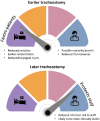Tracheostomy for COVID-19: evolving best practice
- PMID: 34461964
- PMCID: PMC8405347
- DOI: 10.1186/s13054-021-03674-7
Tracheostomy for COVID-19: evolving best practice
Erratum in
-
Correction: Selected articles from the annual update in Intensive Care and Emergency Medicine 2021.Crit Care. 2024 Apr 5;28(1):110. doi: 10.1186/s13054-024-04857-8. Crit Care. 2024. PMID: 38581042 Free PMC article. No abstract available.
Abstract
This article is one of ten reviews selected from the Annual Update in Intensive Care and Emergency Medicine 2021. Other selected articles can be found online at https://www.biomedcentral.com/collections/annualupdate2021 . Further information about the Annual Update in Intensive Care and Emergency Medicine is available from https://link.springer.com/bookseries/8901 .
© 2021. Williams and McGrath.
Conflict of interest statement
The authors have no conflicts of interests to declare.
Figures




References
-
- Intensive Care National Audit & Research Centre. ICNARC report on COVID-19 in critical care: England, Wales and Northern Ireland. Available at https://www.icnarc.org/Our-Audit/ Audits/Cmp/Reports. Accessed 7 Feb 2021.
Publication types
MeSH terms
Substances
LinkOut - more resources
Full Text Sources
Medical

